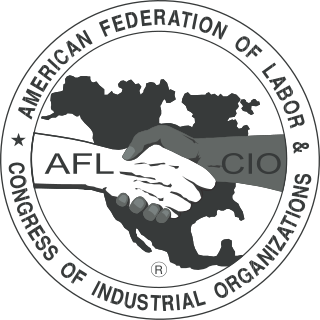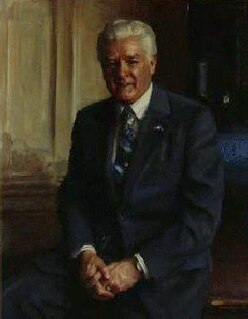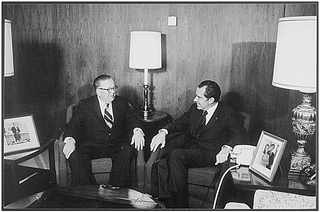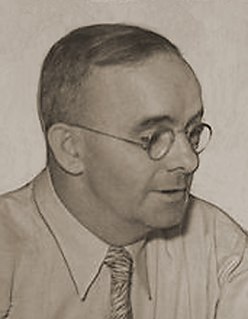The Teamsters had been expelled from the AFL-CIO in 1957 for corruption. [3] [4] The UAW had disaffiliated from the AFL-CIO on July 1, 1968, after UAW President Walter Reuther and AFL-CIO President George Meany could not come to agreement on a wide range of policy issues or reforms to AFL-CIO governance. [5] Although Teamsters president Frank Fitzsimmons was originally seen as a proxy for jailed Teamsters president Jimmy Hoffa, Fitzsimmons had begun taking a more leftist stand on a number of public policy issues. [5] Reuther was particularly impressed that Fitzsimmons had been the only other national labor leader present at the funeral of Martin Luther King, Jr. [3] [5]
On July 24, 1968, just days after the UAW disaffiliation, Fitzsimmons and Reuther formed the Alliance for Labor Action to organize unorganized workers and pursue leftist political and social projects. [6] [7] While Reuther himself remained active in the ALA, Fitzsimmons assigned Teamsters leader Harold J. Gibbons as his union's liaison. [5]
Fitzsimmons and Reuther offered the AFL-CIO a no-raid pact as a first step toward building a working relationship between the competing trade union centers, but the offered was rejected. [7] [8] AFL-CIO President George Meany denounced the ALA as a dual union, although Reuther argued it was not. [1] [5] The ALA later passed a resolution permitting ALA members to raid AFL-CIO unions or organize in jurisdictions claimed by AFL-CIO unions if the AFL-CIO-affiliated union was not doing enough to organize workers into union. [2] Although Reuther had a lengthy list of unions he hoped would join the ALA, few did so. [2] [5] In September 1968, the 110,000-member International Chemical Workers Union (now part of the United Food and Commercial Workers) affiliated with the ALA, and was expelled from the AFL-CIO a year later. [9] Ten of the largest local unions (representing 40,000 members) belonging to the Retail, Wholesale and Department Store Union disaffiliated from that international union, formed a new union (the National Council of Distributive Workers of America), and joined the ALA. [10] Although the United Rubber Workers and the Glass Workers both expressed official interest in joining the ALA, neither did so. [11] The ALA's founding split the American Federation of Teachers, which debated joining but never formally considered such an act. [12]
Program and dissolution
The Alliance's initial program was ambitious. [13] The two member unions provided the ALA with an annual budget of $4.5 million, the same amount they would have paid to the AFL-CIO in per capita dues. [2] [5] [7] A major organizing drive targeting African American workers was launched in Atlanta, Georgia, in the fall of 1969 involving 50 staff organizers (half of them black), 200 volunteer member-organizers, a $4 million budget, and an extensive public relations campaign. [2] [5] [14] But the campaign failed: After 28 months, only 4,590 workers had been organized, and 94 of 196 elections won. [2] [14] [15]
The ALA's agenda also included action on a number of progressive issues. It engaged in a widespread community unionism effort. [11] But its attempt to organize blue-collar workers, the poor, and local citizens into community unions was hampered by a lack of experience in community organizing. [2] The ALA program turned into a grant-making operation working through the UAW's existing structure, awarding more than $2.5 million in funds in two and a half years. [2] [5] [16] Although it had little organizational involvement in the anti-Vietnam War peace movement, [17] the ALA called for an immediate end to the war, endorsed anti-war rallies, and its leaders marched in anti-war marches. [1] [7] [18] [19] The trade union center also supported universal health care, and gave an important early boost to modern efforts to pass federal legislation on the issue. [20]
Reuther's death in a plane crash on May 9, 1970, near Black Lake, Michigan, dealt a serious blow to the Alliance. [5] The group halted operations in July 1971 after the Auto Workers (almost bankrupt from a lengthy strike at General Motors) was unable to continue to fund its operations, and the ALA formally disbanded in January 1972. [21] The Ford Foundation assumed control over the community grant programs upon the ALA's disestablishment. [5]
The UAW re-affiliated with the AFL-CIO on July 1, 1981. [22] The Teamsters re-affiliated with the AFL-CIO on October 24, 1987. [23]
Historical assessment
Some commentators conclude that the ALA is unimportant, historically. For example, Harold Meyerson argues that "the Alliance for Labor Action, alas, never really did anything." [24] Others conclude that it never could have evolved into a major force in the American labor movement: The UAW was no longer a potent political force by 1968, the UAW was on the verge losing half a million members and agreeing to major contract concessions in the auto industry, and neither the UAW nor Teamsters had much organizing capacity (neither had engaged in any significant efforts to organize new members for decades). [25]
Other commentators disagree. The ALA, some historians say, gave the anti-war movement a voice for the first time within the labor movement. [18] [19] Although the ALA's own community organizing efforts failed, they encouraged and promoted a long-lasting (if small) community organizing effort in some major cities which survived into the 21st century. [2] Commentators at the time of Reuther's death and a quarter-century later have also concluded that it was Reuther's untimely demise which led to the ALA's failure, rather than anything inherent in its members, structure, or goals. [5] [26]

The American Federation of Labor and Congress of Industrial Organizations (AFL–CIO) is the largest federation of unions in the United States. It is made up of fifty-five national and international unions, together representing more than 12 million active and retired workers. The AFL–CIO engages in substantial political spending and activism, typically in support of liberal or progressive policies.

Walter Philip Reuther was an American leader of organized labor and civil rights activist who built the United Automobile Workers (UAW) into one of the most progressive labor unions in American history. He saw labor movements not as narrow special interest groups but as instruments to advance social justice and human rights in democratic societies. He leveraged the UAW's resources and influence to advocate for workers' rights, civil rights, women's rights, universal health care, public education, affordable housing, environmental stewardship and nuclear nonproliferation around the world. He believed in Swedish-style social democracy and societal change through nonviolent civil disobedience. He cofounded the AFL-CIO in 1955 with George Meaney. He survived two attempted assassinations, including one at home where he was struck by a 12-gauge shotgun blast fired through his kitchen window. He was the fourth and longest serving president of the UAW, serving from 1946 until his death in 1970.

The International Union, United Automobile, Aerospace, and Agricultural Implement Workers of America, better known as the United Auto Workers (UAW), is an American labor union that represents workers in the United States and Canada. It was founded as part of the Congress of Industrial Organizations (CIO) in the 1930s and grew rapidly from 1936 to the 1950s. The union played a major role in the liberal wing of the Democratic Party under the leadership of Walter Reuther. It was known for gaining high wages and pensions for auto workers, but it was unable to unionize auto plants built by foreign-based car makers in the South after the 1970s, and it went into a steady decline in membership; reasons for this included increased automation, decreased use of labor, movements of manufacturing, and increased globalization.

The International Brotherhood of Teamsters (IBT), also known as the Teamsters Union, is a labor union in the United States and Canada. Formed in 1903 by the merger of The Team Drivers International Union and The Teamsters National Union, the union now represents a diverse membership of blue-collar and professional workers in both the public and private sectors. The union has approximately 1.3 million members as of 2020. Formerly known as the International Brotherhood of Teamsters, Chauffeurs, Warehousemen and Helpers of America, the IBT is a member of the Change to Win Federation and Canadian Labour Congress.
The Communist Party (CP) and its allies played a role in the United States labor movement, particularly in the 1930s and 1940s, but never succeeded, with rare exceptions, either in bringing the labor movement around to its agenda or in converting their influence in any particular union into membership gains for the Party. The CP has had only negligible influence in labor since its supporters' defeat in internal union political battles in the aftermath of World War II and the CIO's (CIO) expulsion of unions in which the party held the most influence in 1950.

John Joseph Sweeney was an American labor leader who served as president of the AFL-CIO from 1995 to 2009.

William George Meany was an American labor union leader for 57 years. He was the key figure in the creation of the AFL-CIO and served as the AFL-CIO's first president, from 1955 to 1979.

Peter Joseph Brennan was an American labor activist and politician who served as United States Secretary of Labor from February 2, 1973 until March 15, 1975 in the administrations of Presidents Nixon and Ford. Brennan had previously been the president of both the Building and Construction Trades Council of Greater New York and the Building and Construction Trades Council of New York, and he returned to the former position after leaving the Ford administration. He was a strong opponent of affirmative action measures to increase the number of minority construction workers. After organizing a demonstration in support of the Nixon administration that turned into the Hard Hat Riot of May 8, 1970, where construction workers violently attacked student anti-war protesters, Brennan was wooed by the Nixon administration as a potential supporter in the 1972 presidential election. His work for Nixon in that election was crucial in increasing the vote for Nixon in New York and in the union movement.

Frank Edward Fitzsimmons was an American labor leader. He was acting president of the International Brotherhood of Teamsters from 1967 to 1971, and president from 1971 to 1981.
Daniel Joseph Tobin was an American labor leader and president of the International Brotherhood of Teamsters from 1907 to 1952. From 1917 to 1928, he was secretary-treasurer of the American Federation of Labor. He served on the federation's Executive Council beginning in 1934, and served until his resignation in 1952.

Roland Jay Thomas, also known as R. J. Thomas, was born in East Palestine, Ohio. He grew up in eastern Ohio and attended the College of Wooster for two years. The need to help support his family caused him to leave college and go to work. In 1923, he moved to Detroit, where he worked in a number of automobile plants.

Retail, Wholesale and Department Store Union (RWDSU) is a labor union in the United States. Founded in 1937, the RWDSU represents about 60,000 workers in a wide range of industries, including but not limited to retail, grocery stores, poultry processing, dairy processing, cereal processing, soda bottlers, bakeries, health care, hotels, manufacturing, public sector workers like crossing guards, sanitation, and highway workers, warehouses, building services, and distribution.

Giovanni Ignazio Dioguardi, known as John "Johnny Dio" Dioguardi, was an Italian-American organized crime figure and a labor racketeer. He is known for being involved in the acid attack which led to the blinding of newspaper columnist Victor Riesel, and for his role in creating fake labor union locals to help Jimmy Hoffa become General President of the Teamsters.
David John McDonald was an American labor leader and president of the United Steelworkers of America from 1952 to 1965.

Emil Rieve was an American labor leader. He was president of the Textile Workers Union of America (TWUA) from 1939 to 1956, a vice president of the Congress of Industrial Organizations (CIO) from 1939 to 1955, and a vice president of the AFL-CIO from 1955 to 1960.
George Hardy was a Canadian-American labor leader who was president of the Service Employees International Union (SEIU) from 1971 to 1980. At the time of his death, SEIU had grown to become the fifth-largest affiliate of the AFL-CIO. Hardy was a vice president of the AFL-CIO from 1972 to 1980, and a member of its executive council. He was a former member of the Democratic National Committee and the California Democratic State Central Committee.

Wyndham Mortimer was an American trade union organizer and functionary active in the United Auto Workers union (UAW). Mortimer is best remembered as a key union organizer in the 1937 Flint Sit-Down Strike. Mortimer was the First Vice President of the UAW from 1936 to 1939. A member of the Communist Party USA from about 1932, Mortimer was a critic of the efforts of the conservative American Federation of Labor to control the union and was a leader of a so-called "Unity Caucus" which led the UAW to join forces with the more aggressive Congress of Industrial Organizations (CIO).

The Congress of Industrial Organizations (CIO) was a federation of unions that organized workers in industrial unions in the United States and Canada from 1935 to 1955. Created in 1935 by John L. Lewis, who was a part of the United Mine Workers (UMW), it was originally called the Committee for Industrial Organization but changed its name in 1938 when it broke away from the American Federation of Labor (AFL). It also changed names because it was not successful with organizing unskilled workers with the AFL.
The Chrysler Auto Strike began in October 1939 in Detroit, Michigan, as a struggle between the Chrysler Auto manufacturer and The International Union, United Automobile, Aerospace and Agricultural Implement Workers of America, better known as the United Automobile Workers (UAW). The strike began in October 1939 in Detroit, Michigan.














